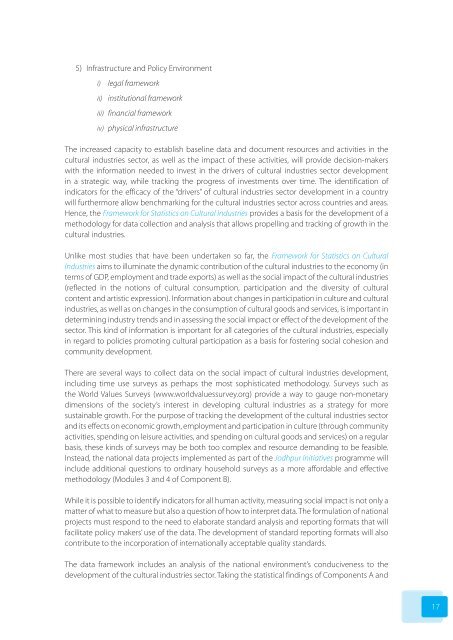Statistics on Cultural Industries - International Trade Centre
Statistics on Cultural Industries - International Trade Centre
Statistics on Cultural Industries - International Trade Centre
- No tags were found...
You also want an ePaper? Increase the reach of your titles
YUMPU automatically turns print PDFs into web optimized ePapers that Google loves.
5)Infrastructure and Policy Envir<strong>on</strong>menti) legal frameworkii) instituti<strong>on</strong>al frameworkiii) financial frameworkiv) physical infrastructureThe increased capacity to establish baseline data and document resources and activities in thecultural industries sector, as well as the impact of these activities, will provide decisi<strong>on</strong>-makerswith the informati<strong>on</strong> needed to invest in the drivers of cultural industries sector developmentin a strategic way, while tracking the progress of investments over time. The identificati<strong>on</strong> ofindicators for the efficacy of the “drivers” of cultural industries sector development in a countrywill furthermore allow benchmarking for the cultural industries sector across countries and areas.Hence, the Framework for <str<strong>on</strong>g>Statistics</str<strong>on</strong>g> <strong>on</strong> <strong>Cultural</strong> <strong>Industries</strong> provides a basis for the development of amethodology for data collecti<strong>on</strong> and analysis that allows propelling and tracking of growth in thecultural industries.Unlike most studies that have been undertaken so far, the Framework for <str<strong>on</strong>g>Statistics</str<strong>on</strong>g> <strong>on</strong> <strong>Cultural</strong><strong>Industries</strong> aims to illuminate the dynamic c<strong>on</strong>tributi<strong>on</strong> of the cultural industries to the ec<strong>on</strong>omy (interms of GDP, employment and trade exports) as well as the social impact of the cultural industries(reflected in the noti<strong>on</strong>s of cultural c<strong>on</strong>sumpti<strong>on</strong>, participati<strong>on</strong> and the diversity of culturalc<strong>on</strong>tent and artistic expressi<strong>on</strong>). Informati<strong>on</strong> about changes in participati<strong>on</strong> in culture and culturalindustries, as well as <strong>on</strong> changes in the c<strong>on</strong>sumpti<strong>on</strong> of cultural goods and services, is important indetermining industry trends and in assessing the social impact or effect of the development of thesector. This kind of informati<strong>on</strong> is important for all categories of the cultural industries, especiallyin regard to policies promoting cultural participati<strong>on</strong> as a basis for fostering social cohesi<strong>on</strong> andcommunity development.There are several ways to collect data <strong>on</strong> the social impact of cultural industries development,including time use surveys as perhaps the most sophisticated methodology. Surveys such asthe World Values Surveys (www.worldvaluessurvey.org) provide a way to gauge n<strong>on</strong>-m<strong>on</strong>etarydimensi<strong>on</strong>s of the society’s interest in developing cultural industries as a strategy for moresustainable growth. For the purpose of tracking the development of the cultural industries sectorand its effects <strong>on</strong> ec<strong>on</strong>omic growth, employment and participati<strong>on</strong> in culture (through communityactivities, spending <strong>on</strong> leisure activities, and spending <strong>on</strong> cultural goods and services) <strong>on</strong> a regularbasis, these kinds of surveys may be both too complex and resource demanding to be feasible.Instead, the nati<strong>on</strong>al data projects implemented as part of the Jodhpur Initiatives programme willinclude additi<strong>on</strong>al questi<strong>on</strong>s to ordinary household surveys as a more affordable and effectivemethodology (Modules 3 and 4 of Comp<strong>on</strong>ent B).While it is possible to identify indicators for all human activity, measuring social impact is not <strong>on</strong>ly amatter of what to measure but also a questi<strong>on</strong> of how to interpret data. The formulati<strong>on</strong> of nati<strong>on</strong>alprojects must resp<strong>on</strong>d to the need to elaborate standard analysis and reporting formats that willfacilitate policy makers’ use of the data. The development of standard reporting formats will alsoc<strong>on</strong>tribute to the incorporati<strong>on</strong> of internati<strong>on</strong>ally acceptable quality standards.The data framework includes an analysis of the nati<strong>on</strong>al envir<strong>on</strong>ment’s c<strong>on</strong>duciveness to thedevelopment of the cultural industries sector. Taking the statistical findings of Comp<strong>on</strong>ents A and17
















